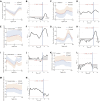Immediate changes in stroke patients' gait following the application of lower extremity elastic strap binding technique
- PMID: 39324104
- PMCID: PMC11422075
- DOI: 10.3389/fphys.2024.1441471
Immediate changes in stroke patients' gait following the application of lower extremity elastic strap binding technique
Abstract
Objective: To ascertain the immediate changes in stroke patients' temporal and spatial parameters of gait and the joint angles of stroke patients throughout the entire gait cycle following the application of lower extremity elastic strap binding technique.
Methods: Twenty-nine stroke patients were invited as the study participants. The patient seated, flexed the hip and knee, utilized a 5 cm-wide elastic strap, positioning its midpoint beneath the affected foot and crossing it anterior to the ankle joint. Upon standing, the strap encircled the posterior aspect of the lower leg, proceeded around the back of the knee, and ascended the thigh on the affected side. Crossing anteriorly over the thigh, it then encircled the back of the waist before being secured in place. Using Qualisys motion capture system to collect kinematic data of the lower extremities during walking while wearing shoes only or strapping. A paired sample t-test was used to analyze the effects of the technique on gait spatiotemporal parameters and joint angles in stroke patients.
Results: The patients' step length decreased (P = 0.024), and step width increased (P = 0.008) during the gait cycle after the strapping. In the gait cycle between 0% and 2%, 7%-77%, and 95%-100%, the hip flexion angle on the affected side was significantly larger after the strapping (P < 0.05). In the gait cycle between 0% to 69% and 94%-100%, the knee flexion angle on the affected side was significantly larger after the strapping (P < 0.05). In the gait cycle between 0% to 57% and 67%-100%, the ankle dorsiflexion angle on the affected side was significantly smaller after the strapping (P < 0.05), and in the gait cycle between 0% to 35% and 68%-100%, the ankle inversion angle on the affected side was significantly smaller after the strapping (P < 0.05).
Conclusion: The lower extremity elastic strap binding technique can decrease the hip flexion and knee flexion limitations in stroke patients during walking, and reduce the ankle plantar flexion and ankle inversion angle of stroke patients. The lower extremity elastic strap binding technique enabled stroke patients to adopt a more stable gait pattern.
Keywords: gait; joint angles; lower extremity elastic strap binding technique; statistical parametric mapping; stroke.
Copyright © 2024 Liu, Wang, Li, Cui, Chen and Wan.
Conflict of interest statement
The authors declare that the research was conducted in the absence of any commercial or financial relationships that could be construed as a potential conflict of interest.
Figures


Similar articles
-
Kinematic on Ankle and Knee Joint of Post-Stroke Elderly Patients by Wearing Newly Elastic Band-Type Ankle-Foot Orthosis in Gait.Clin Interv Aging. 2019 Dec 5;14:2097-2104. doi: 10.2147/CIA.S222087. eCollection 2019. Clin Interv Aging. 2019. PMID: 31824140 Free PMC article.
-
Contributions to the understanding of gait control.Dan Med J. 2014 Apr;61(4):B4823. Dan Med J. 2014. PMID: 24814597 Review.
-
Clinical study on low-frequency repetitive transcranial magnetic stimulation for the treatment of walking dysfunction following stroke through three-dimensional gait analysis.Psychogeriatrics. 2024 Mar;24(2):182-194. doi: 10.1111/psyg.13058. Epub 2024 Jan 2. Psychogeriatrics. 2024. PMID: 38168071 Clinical Trial.
-
Effect of Leg Extension Angle on Knee Flexion Angle during Swing Phase in Post-Stroke Gait.Medicina (Kaunas). 2021 Nov 9;57(11):1222. doi: 10.3390/medicina57111222. Medicina (Kaunas). 2021. PMID: 34833440 Free PMC article.
-
Evaluation of lower extremity gait analysis using Kinect V2® tracking system.SICOT J. 2022;8:27. doi: 10.1051/sicotj/2022027. Epub 2022 Jun 24. SICOT J. 2022. PMID: 35748723 Free PMC article.
Cited by
-
Effect of an Ankle Stabilization Strap Using a Badaging Technique on Ankle Range of Motion, Balance, and Spatiotemporal Gait Parameters in Patients with Chronic Stroke: A Randomized Controlled Trial.Life (Basel). 2025 Aug 14;15(8):1291. doi: 10.3390/life15081291. Life (Basel). 2025. PMID: 40868939 Free PMC article.
References
-
- Cohen J. (2013). Statistical power analysis for the behavioral sciences. New York: Routledge.
Associated data
LinkOut - more resources
Full Text Sources

